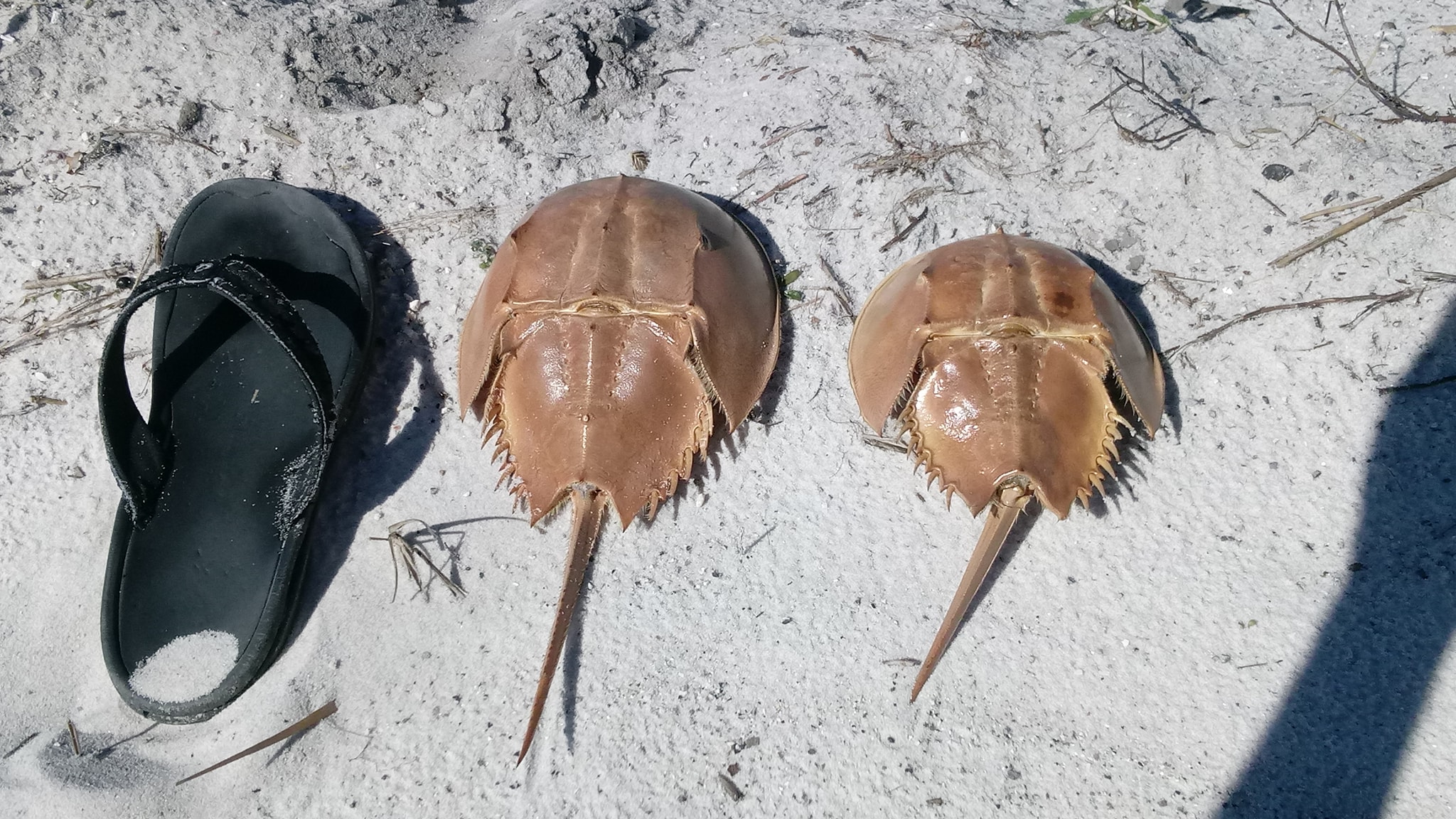One of the community science volunteer projects I oversee in the Pensacola area is the Florida Horseshoe Crab Watch. The first objective of this project is to determine whether horseshoe cabs exist in your bay – FYI, they do exist in Pensacola Bay. The second objective is to determine where they are nesting – we have not found that yet, but we have one location that looks promising. One of the things my volunteers frequently find are the molts of the horseshoe crabs. Many keep them and I have quite a few in my office as well. One volunteer was particularly interested in the fact that they even molted and that they could leave this amazing empty shell behind and yet still be crawling around out there. So, I decided to write an article explaining the process in a little more depth than I typically do.

Photo: Holly Forrester
I titled the article “The Molting of Crabs” but it could be the molting of any member of the Phylum Arthropoda – they all do this. The Phylum Arthropoda is the largest, most diverse, and successful group of animals on the planet. There are at least 750,000 species of them. This is three times the number of all other animal species combined. One thing unique to this group is the presence of an exoskeleton.
The exoskeleton is made of chiton and is secreted by the animal’s hypodermis in two layers. It provides the protection that the calcium carbonate shells of mollusk do but is much lighter in weight and allows for much more movement. Arthropods have jointed legs, hence their name “arthropod – jointed foot”, to enhance this movement even more. The entire body is covered by this exoskeleton.
The outer layer is thin and called the epicuticle. It is composed of proteins and, in many arthropods, wax. The inner layer is the thicker procuticle. The procuticle consists of an outer exocuticle and an inner endocuticle. These are composed of chiton and protein bound to form a complex glycoprotein. The exocuticle is absent at joints in the legs and along lines where the shell will rupture during molting. In the marine arthropods the procuticle includes salts and minerals. Where the epicuticle is not waxy and is thin, gases and water can pass into the animal’s body. The cuticle also has small pores that allow the release of compounds produced by glands within the animal. Not all of the cuticle is produced on the outside of the body. Some portions of it are produced around internal organs.
The colors of the crabs and other arthropods are produced by concentrations of brown, yellow, orange, and red melanin pigments within the cuticle. Iridescent greens, purples, and other colors are produced by striations of the epicuticle refracting light.
One disadvantage of the protective exoskeleton is the fact that it does not grow as fast as the interior soft tissue. They have solved this problem by periodic shedding, or molting, of the shell. Science calls this ecdysis, but we will continue to call it “molting”.
Step one is the detachment of the hypodermis from the skeleton. The hypodermis now secretes a new epicuticle. Step two, the hypodermis releases enzymes which pass through the new epicuticle and begin to erode the untanned endocuticle of the old skeleton. During this process the muscles and nerves are not affected and the animal can continue to move and feed. Step three, the old endocuticle is now completely digested. With the new procuticle produced by the hypodermis, the animal is now encased by both the old and new skeleton. Step four, the old skeleton now splits along predetermined lines, and the animal pulls out of the old skeleton. The new exoskeleton is soft – hence, the “soft-shelled blue crab” – and can be stretched to cover the increased size of the new animal. This stretching occurs due to tissue growth during steps 1-3, and from the uptake of air and water. The hardening of the new skeleton occurs due to the tanning of the new cuticle.
Stages between molts become longer as the animal grows older. Thus, there are numerous molts when the animal is young and as they age, they become fewer and farther between. Most insects have a finite number of molts they will go through. The marine arthropods seem to molt throughout their lives, though some species of crabs cease molting once they reach sexual maturity.
Molting is under hormonal control. Ecdyisone is secreted by certain endocrine glands, circulated through the blood stream, and acts directly on the epidermal cells. There are hormones that, if secreted, will inhibit the molting process. These are usually released if the animal senses trouble and that is not a good time.
During the period when the old shell is being digested many of the salts and minerals are absorbed by the tissue of the animal. Some people can eat crab but have allergic reactions when consuming soft shell crabs – most likely due to the increased salts and minerals in the tissue at this time. During step 3, many crustaceans will seek shelter and will remain there for a period of time after molting allowing the new shell to harden. The regeneration of lost limbs occurs during the molting process as well.
Molts of many species are hard to find because the “soft-shelled” animal can consume the molt to increase needed salts and minerals – or other marine animals may do so for the same reason. But horseshoe crab molts are pretty common and cool to collect. Another common molt found is that of the cicadids in the pine forest areas of our panhandle. The entire process is pretty amazing.
Reference
Barnes, R.D. 1980. Invertebrate Zoology. Saunders College Publishing. Philadelphia PA. pp. 1089.
 2
2
